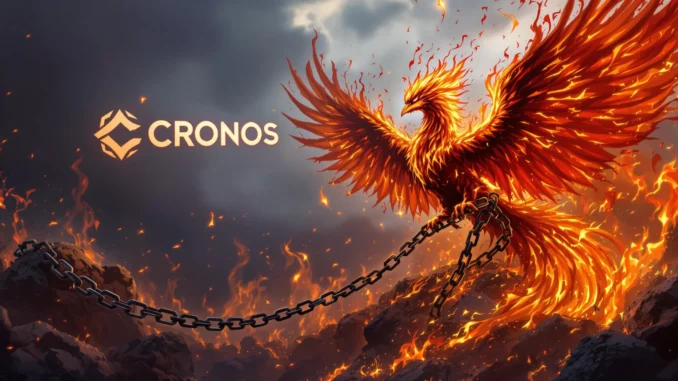
The Cronos (CRO) community is buzzing with debate! A proposal to reissue a massive 70 billion CRO tokens, previously burned in 2021, has ignited a firestorm of discussion and, more importantly, strong opposition. Let’s dive into this developing story and understand why this token reissuance proposal is causing such a stir within the Cronos ecosystem.
Why is Cronos Proposing to Reissue Burned CRO Tokens?
To understand the current controversy, we need to rewind to 2021. Cronos, the Ethereum Virtual Machine (EVM) compatible chain, underwent a significant token burn, removing 70 billion CRO from circulation. This burn was intended to reduce the total supply, potentially increasing scarcity and value for existing CRO holders. Fast forward to today, and the Cronos team is suggesting a dramatic reversal: bringing those burned tokens back into existence.
While the official reasons behind this proposal are still unfolding, we can speculate on some potential motivations:
- Funding Ecosystem Growth: Reissuing a substantial amount of CRO could provide Cronos with significant capital. This capital could be used to fund various initiatives aimed at expanding the Cronos ecosystem. Think about developer grants, marketing campaigns, strategic partnerships, and infrastructure improvements.
- Liquidity Boost: Injecting 70 billion CRO back into the market could drastically increase liquidity. This might be seen as beneficial for trading and overall market activity on the Cronos chain.
- Addressing Unforeseen Needs: The crypto landscape is constantly evolving. Perhaps Cronos has identified new strategic needs or challenges that require a significant influx of resources, and reissuing tokens is seen as the most direct way to address these.
However, despite these potential benefits, the initial reaction from the Cronos community, particularly the validators, has been overwhelmingly negative. Let’s examine the scale of this opposition.
Validator Vote: A Resounding ‘No’ to Token Reissuance?
Decrypt reported on the early stages of voting on this contentious proposal. In the world of blockchain, validators play a crucial role in network security and governance. In this instance, Cronos validators are weighing in on a critical decision regarding the future of the CRO token supply. The initial results paint a clear picture: crypto governance on Cronos is alive and well, and the validators are not easily swayed.
Here’s a breakdown of the early voting data:
| Metric | Value |
|---|---|
| Validators Participating | 16 out of 100 active validators |
| Voting Power Against Reissuance | 95.7% |
| Voting Power For Reissuance | 3.45% |
| CRO Tokens Representing ‘No’ Votes | Approximately 673 million CRO |
These numbers are stark. With nearly 96% of the voting power in the early stages opposing the Cronos CRO token reissuance, it sends a powerful message. It suggests a deep-seated concern among validators about the potential negative impacts of this proposal.
What are the Concerns Driving the Opposition?
Why are validators so strongly against reissuing these burned tokens? Several key concerns likely fuel this opposition:
- Inflationary Pressure: The most immediate concern is inflation. Injecting 70 billion CRO back into circulation could significantly increase the token supply, potentially diluting the value of existing CRO holdings. Validators, who often hold substantial amounts of CRO, are understandably wary of actions that could devalue their assets.
- Breach of Trust: The original token burn was seen as a positive move, demonstrating a commitment to scarcity and long-term value. Reversing this decision could be perceived as a breach of trust with the community. It raises questions about the reliability of past promises and future commitments from the Cronos team.
- Market Sentiment: The crypto market is highly sensitive to tokenomics. A sudden and significant increase in token supply could negatively impact market sentiment towards CRO. This could lead to price drops and decreased investor confidence.
- Lack of Transparency: So far, the communication surrounding the rationale for reissuing tokens appears to be lacking in detail. Validators and the broader community may be demanding more transparency and a clearer justification for such a drastic measure. What specific problems is this reissuance intended to solve? How will the funds be used, and what are the projected benefits?
Potential Benefits of Reissuing CRO: Are There Any?
While the opposition is strong, it’s important to consider if there could be any legitimate benefits to reissuing the Cronos CRO tokens. It’s unlikely the Cronos team would propose this without some perceived advantages. Let’s explore potential upsides, even if they are currently overshadowed by concerns:
- Ecosystem Funding: As mentioned earlier, a large influx of CRO could provide substantial funding for ecosystem development. If strategically deployed, this could lead to long-term growth and value creation for the Cronos network. Imagine accelerated development of new decentralized applications (dApps), enhanced infrastructure, and expanded marketing reach.
- Strategic Reserves: Having a significant reserve of CRO could provide Cronos with flexibility to respond to future market challenges or opportunities. It could act as a war chest for strategic acquisitions, partnerships, or to weather unforeseen economic storms in the crypto space.
- Attracting Talent and Innovation: Funding from reissued tokens could be used to attract top talent to the Cronos ecosystem. This could include developers, researchers, and marketers who can contribute to innovation and growth.
However, the crucial question remains: do these potential benefits outweigh the significant risks and the strong community opposition? And can Cronos effectively communicate a compelling vision that justifies this controversial move?
What Happens Next? Navigating the Road Ahead for Cronos
The early validator vote is a strong indicator of the current sentiment, but the final outcome is still uncertain. Here’s what to watch for as this situation unfolds:
- Full Validator Voting: The voting process is likely ongoing, and we need to see the results when all 100 active validators have cast their votes. Will the overwhelming opposition hold, or will there be a shift in sentiment?
- Cronos Team Response: The Cronos team needs to address the concerns raised by validators and the community. Increased transparency and a clear articulation of the rationale behind the proposal are crucial. Will they revise the proposal, withdraw it, or double down and try to persuade the opposition?
- Community Engagement: Beyond validators, the broader Cronos community’s voice matters. Discussions on social media, forums, and community calls will provide further insights into the overall sentiment. Will community pressure influence the final decision?
- Market Reaction: The market’s reaction to this proposal, and any subsequent developments, will be closely watched. Will the controversy negatively impact the price of CRO? Or will the market remain unfazed, waiting for more clarity?
Conclusion: A Critical Juncture for Cronos
The proposal to reissue 70 billion burned CRO tokens has placed Cronos at a critical juncture. It’s a moment that highlights the complexities of crypto governance and the importance of community consensus. While the potential benefits of ecosystem funding and strategic reserves exist, they are currently overshadowed by significant concerns about inflation, trust, and market sentiment. The overwhelming early opposition from validators underscores the challenges Cronos faces in convincing its community of the merits of this proposal.
Ultimately, the success of Cronos hinges on navigating this controversy effectively. Transparent communication, genuine engagement with the community, and a willingness to address valid concerns will be paramount. The coming days and weeks will be crucial in determining the future trajectory of Cronos and the CRO token. Stay tuned as this story develops – it’s a fascinating case study in the evolving world of decentralized governance and tokenomics.



